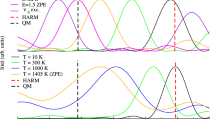Abstract
A theoretical computation of vibrational anharmonicity is presented which is a generalization of the simple Gruneisen approach. The calculation was based on a model that defines a simple relationship between the binding energy of a solid and the variation of vibration frequencies with volume. The agreement between calculated and experimental Gruneisen constants is good.
Similar content being viewed by others
References
L. A. Girifalco, Phys. Rev. B 52, 9910 (1995).
K. Kniaz, L. A. Girifalco, and J. E. Fischer, J. Phys. Chem. 99, 16 804 (1995).
J. A. Rose, J. R. Smith, F. Guinea, and J. Ferrante, Phys. Rev. B. 29, 2963 (1984).
See, for example, L. A. Girifalco, Statistical Physics of Materials (Wiley, New York, 1973), Chap. 2.
The CRC Materials Science and Engineering Handbook, edited by J. Shackelford and W. Alexander (CRC Press, Boca Raton, FL, 1992); The American Institute of Physics Handbook, Second Edition (McGraw-Hill, New York, 1957).
J. De Launay, Solid State Physics; Advances in Research and Applications (1956), Vol. 2.
Author information
Authors and Affiliations
Rights and permissions
About this article
Cite this article
Girifalco, L.A., Kniaz, K. Anharmonicity in metals from the universal energy equation. Journal of Materials Research 12, 311–313 (1997). https://doi.org/10.1557/JMR.1997.0042
Received:
Accepted:
Published:
Issue Date:
DOI: https://doi.org/10.1557/JMR.1997.0042




